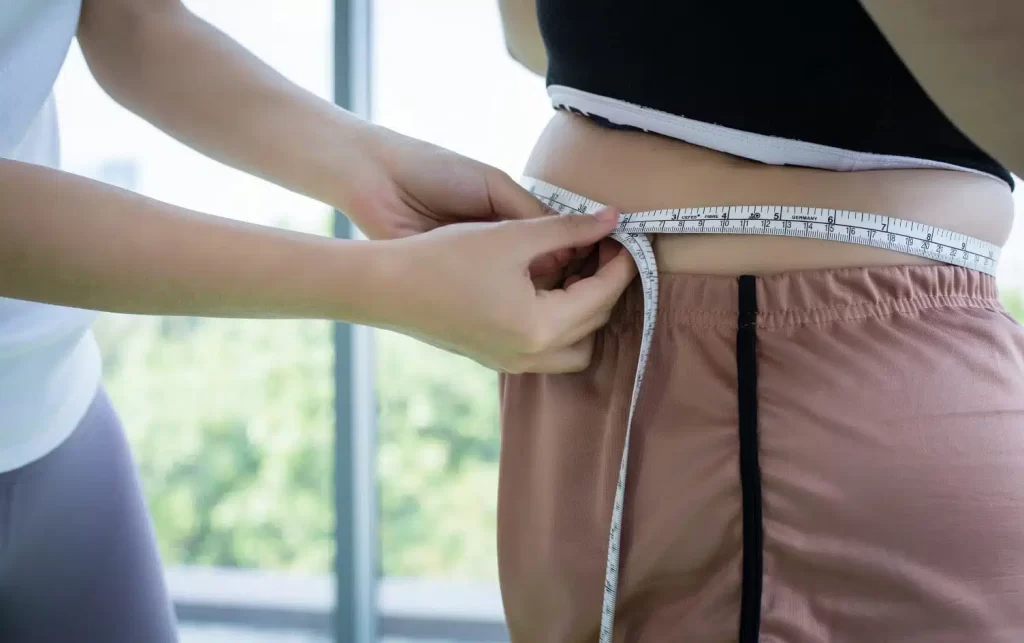It’s every weight loss enthusiast’s dream to zap belly fat but, far from pure vanity, there’s actually a reason why having a lot of fat in the abdominal region can be dangerous, especially visceral fat. Fat is stored all over our body, but how does an expanding waistline grow your risk for chronic illness?
Your body’s fat impacts your health differently depending on where it’s stored. While most fat found on other parts of our bodies (think arms, legs, buttocks) are considered “subcutaneous fat,” belly fat is more likely to be “visceral.”
“Subcutaneous fat” is the pinchable, squishy fat right between your skin and muscle that helps keep you warm, cushions you against shock, and stores extra calories. “Visceral fat” stores calories too, but isn’t as pinchable because it is located in and around your organs. It’s hidden deep within the belly region, which is what makes it firm (rather than squishy) when you press it.
Fat doesn’t just store calories—it’s a living tissue capable of producing and releasing hormones that affect your other organs. Because visceral fat sits near our organs, its release of these chemicals is poorly situated. Having more visceral fat can raise your LDL (a.k.a. “bad” cholesterol) and blood pressure. Visceral fat can also make you less sensitive to insulin, which increases your risk for Type 2 Diabetes.
Even if you’re thin, you can still have visceral fat around the abdominal region—being “skinny” doesn’t necessarily mean you’re healthy. There’s no sure-fire way to tell visceral from subcutaneous fat short of an expensive CT scan, but it’s important for you to get a rough idea of what your visceral stores are. Here are a few tricks to figure out where your belly stands:
APPLES AND PEARS: You’re probably wondering, “What does fruit have to do with it?” These two fruits give a quick visual of where most of your fat is stored on the body. Pears tend to store fat in the lower extremities (hips, thighs, buttocks) as subcutaneous fat while apples tend to store fat in the upper region (belly, chest) as visceral fat. It takes a quick inspection, but this is an imperfect way to tell these two fats apart.
WAIST CIRCUMFERENCE (WC): Feel for the top of your hip bone (it’s at the same level as the top of your belly button) and circle a tape measure around this point. Remember to relax and don’t suck in your gut (be honest!). Take 2-3 measurements and figure out the average. Men should have a WC of less than 40 inches (102 cm) and women should have a WC of less than 35 inches (89 cm).
WAIST-TO-HIP RATIO: The waist-to-hip ratio (WHR) takes the circumference of your waist (see above) and divides it by the circumference of your hips. To measure your hips, stand in front of a mirror then figure out the widest part of your butt and measure that circumference. Then use this formula:
WHR = (Waist circumference) / (Hip circumference).
Men should have a WHR of less than 1 while women should have a WHR of less than 0.8.
If your parents or siblings have insulin resistance, heart disease or non-alcoholic fatty liver, you may be at a greater risk for storing visceral fat. Keeping an eye on your visceral fat may be beneficial, but know that the causes of these chronic diseases are complex. If you’re in doubt, it’s best to speak with your healthcare provider.
If you fall in the normal range for WC and WHR, that’s great! Keep working at your weight goals as you see fit. If you’re not there, don’t despair. Because of its proximity to the liver, visceral fat is usually the easier fat to burn. It’s the less risky subcutaneous fat that likes to stick around.
Unfortunately, you can’t forcefully spot reduce fat around your belly no matter how many crunches you do. The next best thing is to live a healthy lifestyle:
- Go beyond weight tracking. You can track your waist, hip and even neck circumference in the MyFitnessPal app to see how your measurements change over time as you lose weight.
- Sweat for 30-60 minutes each day. Visceral fat responds well to regular endurance exercises, such as running, biking, rowing, swimming, that elevate your heart rate. As your body uses fat to fuel exercise, it’ll start using up your visceral stores.
- Eat a well-balanced diet. Eat a diet high in whole grains, fresh fruits and vegetables, and lean protein with calories set for gradual weight loss (e.g. about 1-2 pounds per week). Cut way back on added sugars and alcohol since these nutrients will more likely end up as visceral fat.
- Sleep more, stress less. It’s easier said than done, but in order to take care of your physical body, you have to take care of your mental state. Sleep loss and stress can sabotage your health and fitness goals, so learn more about getting a quality night’s rest and use meditation or yoga to calm your mind. Remember, it’s not just about your health; it’s about your happiness, too.
How do you banish belly fat? Share your comments below.







